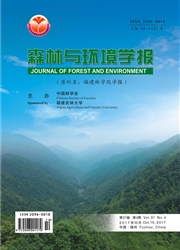

 中文摘要:
中文摘要:
研究3种林龄杉木施肥后第2和第7年生长因子及土壤养分,结果显示:施肥2 a后幼林中N50P100K100Zn25(A3),近熟林中P100K100(C2)、P100K100Cu25(C3)、P100K100Cu25Zn25(C4)施肥处理的树高年增长与CK相比均达到了0.05显著差异水平;A3和中龄杉木N50P100K100(B2)处理的胸径年增长与CK达到了0.05显著水平,施用N50P100K100Zn25的A3和B3处理对杉木蓄积量的增加效果显著。中龄杉木在施肥后第2年土壤p H值高于另两种树龄杉木,施肥后第7年,3种林龄杉木土壤p H值差异不大,随着肥效的下降,3种林龄的p H值趋于稳定,差异变小。幼龄阶段土壤有机质含量低,随着林龄的增加,林下枯枝落叶增多使得碳得以补偿,有机质含量也逐渐增加。施肥后第2年C2处理的全氮含量较CK增幅最大,氮肥的施入可明显提高土壤中N的养分浓度;施肥后幼龄杉木全P相对于背景值增长效果显著,第2年0~20 cm土层增幅达32.2%~41.4%,第7年增幅35%~78.1%;全钾含量不会随着杉木发育周期而发生明显变化。施肥可有效地减缓土壤酸化现象,幼龄增施P肥可以增加各器官的生物量,中龄阶段多施NPK+Zn肥可提高蓄积量,近熟林杉木Cu、Zn肥可改善前期养分损耗的现象,促进杉木对营养元素的吸收,并能有效地提高蓄积量。
 英文摘要:
英文摘要:
The growth factors and soil nutrient of 3 different age Cunninghamia lanceolata plantations at the 2nd and 7th year after fertilization were studied,the results showed that: the fertilization treatments of N50P 100K100Zn25( A3) in the young tree grown and P 100KU〉0( C2),P 100Ku〉0Cu25( C3),P 100K100Cu25Zn25 ( C4) all reached 0.05 significant difference compared with CK in the annual tree height growth after 2 years. Meanwhile the A3 and N50P 100KU〉0( B2) reached 0.05 significant level at DBH growth,and A3 and B3 treatments with N50P 1〇0 Ku〉 0Zn25 had a significant effect on the increment of Cunninghamia lanceolata stock volume. The soil pH value of the mid-aged C. lanceolata in the 2nd year after fertilization was higher than the other 2 forest ages,and the pH value was no significant difference at the 7th year after fertilization. As fertilizer efficiency decrease,the pH value of the 3 kinds of C. lanceolata stand stable. The content of soil organic matter in young stage was low, and as forest age increase, the litter increased and the content of organic matter was growing. The total nitrogen content of C2 treatment was higher than that of CK at the 2nd year after fertilization, and the application of nitrogen fertilizer could significantly increase the concentration of N in soil; compared with the background value,the growth rate of 0?20 cm soil layer in the 2nd year was 32.2% ?41.4%,and the increase was between 35% and 78.1% at the 7th year; the total potassium content didn't change significantly during the development cycle of C. lanceolata. Fertilization can effectivelyrelieve the soil acidification, the application of P fertilizer could increase the biomass of various organs, and NPK and Zn fertilization treatments could increase the amount of accumulation in the mid-age stage, and the Cu with Zn fertilizer in the near mature forest could prevent the nutrient loss and promote nutrient absorption of C.
 同期刊论文项目
同期刊论文项目
 同项目期刊论文
同项目期刊论文
 期刊信息
期刊信息
